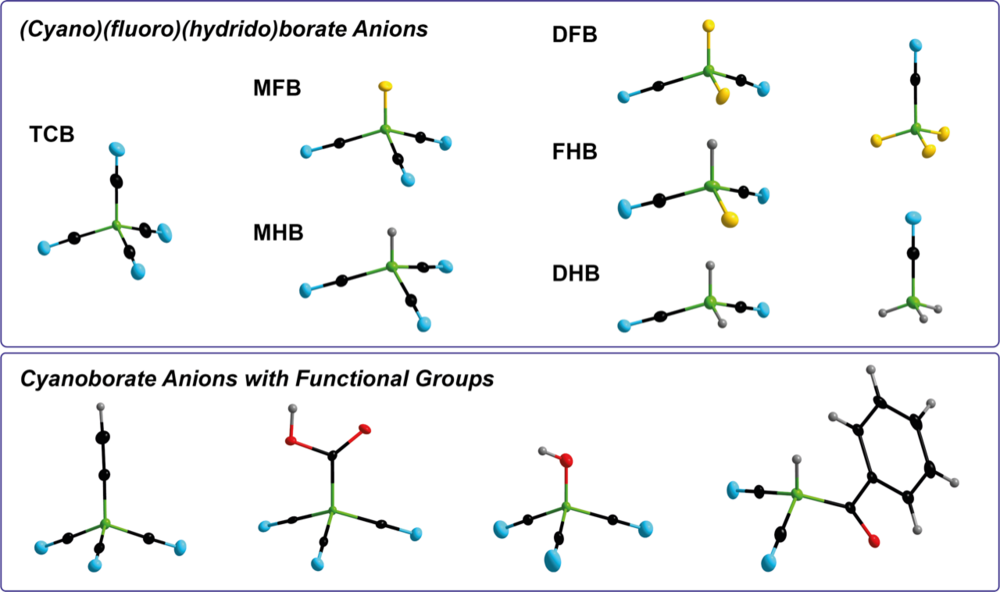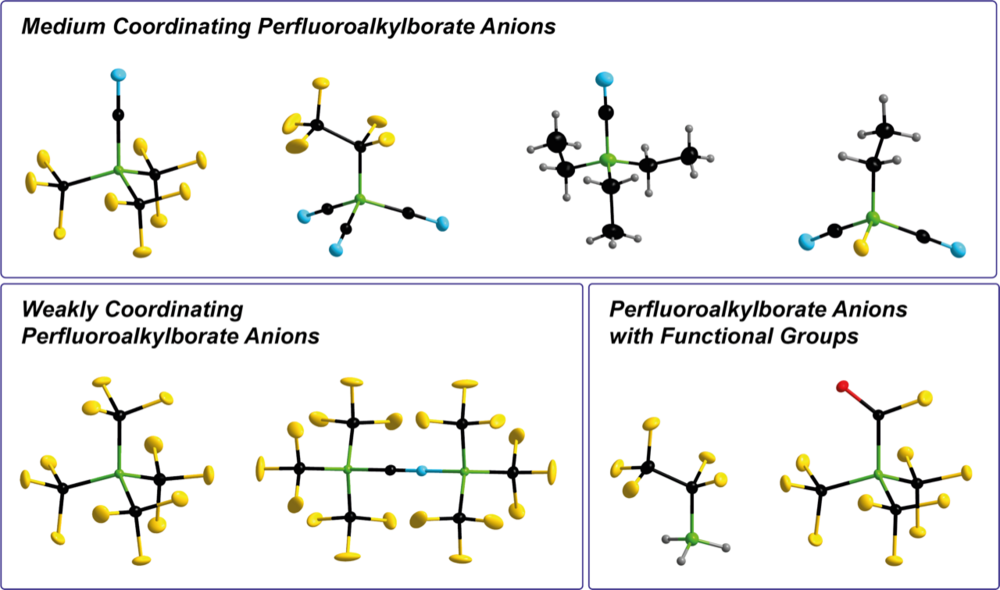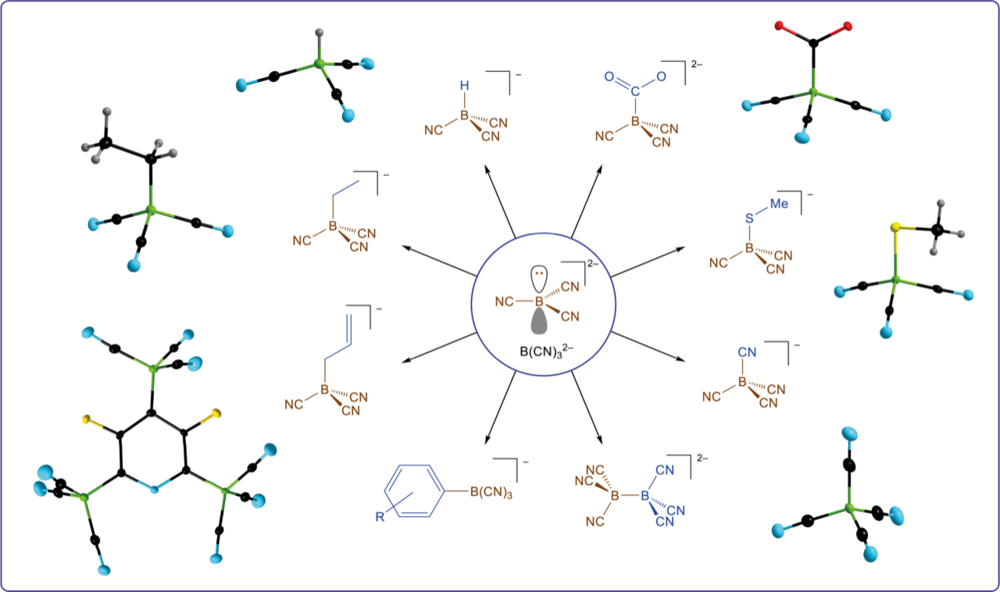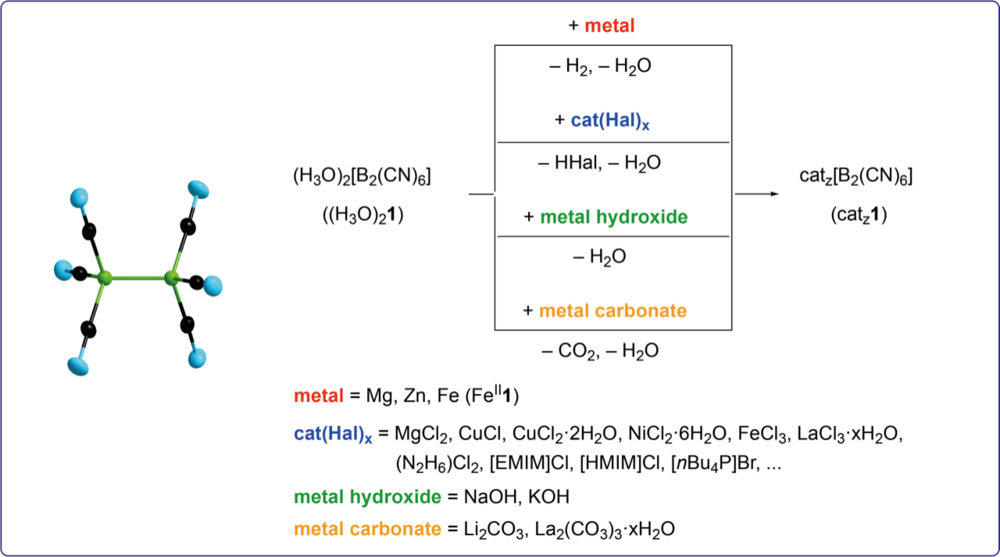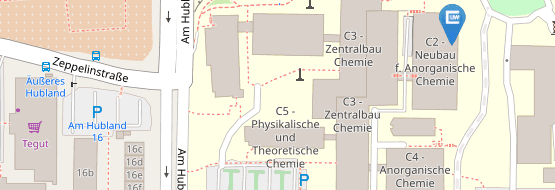Borate Anions & Boryl Anions
Cyanoborate Anions
The properties of cyanoborate anions are tuned by variation of the substituents that are bonded to boron in addition to cyano groups. These substituents include hydrogen, halogen, as well as functional groups such as ethynyl and carboxylate groups. These anions serve as building blocks for the preparation of low-viscosity ionic liquids (ILs), as ligands or medium coordinating anions in coordination chemistry, and as starting materials for the synthesis of borate anions, hypovalent boron derivatives, and cyanoborane adducts.
Publications on this topic:
Cyano(fluoro)borate and cyano(hydrido)borate ionic liquids: Low-viscosity ionic media for electrochemical applications
J. Riefer, L. Zapf, J. A. P. Sprenger, R. Wirthensohn, S. Endres, A.-C. Pöppler, M. Gutmann, L. Meinel, N. V. Ignat’ev, M. Finze, Phys. Chem. Chem. Phys. (PCCP) 2023, DOI: 10.1039/D1032CP05725E.
Alkoxycyanoborates: metal salts and low-viscosity ionic liquids
N. Schopper, J. A. P. Sprenger, L. Zapf, G. J. Reiss, N. V. Ignat’ev, M. Finze, New J. Chem. 2021, 45, 14973–14987.
Innovative Syntheses of Cyano(fluoro)borates: Catalytic Cyanation, Electrochemical and Electrophilic Fluorination
M. Drisch, L. A. Bischoff, J. A. P. Sprenger, P. T. Hennig, R. Wirthensohn, S. Z. Konieczka, M. Hailmann, N. V. Ignat'ev, M. Finze, Chem. Eur. J. 2020, 26, 11625–11633.
Cyanoborates
N. V. Ignat’ev, M. Finze, Eur. J. Inorg. Chem. 2019, 3539–3560.
Alkyl- and Perfluoroalkylborate Anions
Perfluoroalkylborate anions are of potential interest as weakly to medium coordinating anions for the stabilization of reactive cations and for ionic liquid chemistry. The introduction of additional functional groups at boron render perfluoroalkylborate anions synthetic building blocks for materials or synthetic chemistry.
Publications on this topic:
Ethyl-, vinyl- and ethynylcyanoborates: room temperature borate ionic liquids with saturated and unsaturated hydrocarbon chains
N. Schopper, L. Zapf, J. A. P. Sprenger, N. V. Ignat’ev, M. Finze, Chem. Commun. 2022, 58, 1223–1226.
Perfluoroalkyltricyanoborate and Perfluoroalkylcyanofluoroborate Anions: Building Blocks for Low-Viscosity Ionic Liquids
J. Landmann, J. A. P. Sprenger, P. T. Hennig, R. Bertermann, M. Grüne, F. Würthner, N. V. Ignat'ev, M. Finze, Chem. Eur. J. 2018, 24, 608–623.
Lanthanide trifluoromethyltricyanoborates: Synthesis, crystal structures and thermal properties
T. Ribbeck, C. Kerpen, D. Löw, A. E. Sedykh, K. Müller-Buschbaum, N. V. Ignat'ev, M. Finze, J. Fluorine Chem. 2019, 219, 70–78.
Mechanistic Study on the Fluorination of K[B(CN)4] with ClF Enabling the High Yield and Large Scale Synthesis of K[B(CF3)4] and K[(CF3)3BCN]
E. Bernhardt, M. Finze, H. Willner, Inorg. Chem. 2011, 50, 10268–10273.
Boron-Centered Nucleophiles
Boron-centered nucleophiles are starting compounds for unusual and even unprecedented boron compounds. The tricyanoboryl dianion B(CN)32– is a dianionic boron-centered nucleophile that for example provides access to different types of arenes with B(CN)3substituents, unprecedented tetrele compounds such as the tetraanion [Pb{B(CN)3}4]4–, and the carboxylateborate dianion [(NC)3BCO2]2–.
Publications on this topic:
Dismutation of Tricyanoboryllead Compounds: The Homoleptic Tetrakis(tricyanoboryl)plumbate Tetraanion
M. Häring, C. Kerpen, T. Ribbeck, P. T. Hennig, R. Bertermann, N. V. Ignat’ev, M. Finze, Angew. Chem. Int. Ed. 2022, 61, e202202882.
Borylation of fluorinated arenes using the boron- centred nucleophile B(CN)32– – a unique entry to aryltricyanoborates
J. Landmann, P. T. Hennig, N. V. Ignat'ev, M. Finze, Chem. Sci. 2017, 8, 5962–5968.
Deprotonation of a Hydridoborate Anion
J. Landmann, F. Keppner, D. B. Hofmann, J. A. P. Sprenger, M. Häring, S. H. Zottnick, K. Müller-Buschbaum, N. V. Ignat'ev, M. Finze, Angew. Chem. Int. Ed. 2017, 56, 2795–2799.
Diborate Dianions
Compounds that comprise electron precise B–B bonds have come into focus in recent years. We are especially interested in diborate dianions that are stabilized by cyano groups and that can be handled in air. The homoleptic hexacyanoborate dianion [B2(CN)6]2– is the prototype anion of this type, which is even stable against strong Brønsted acids and that has been isolated as H3O+ salt.
Isolated [B2(CN)6]2–: Small Yet Exceptionally Stable Nonmetal Dianion
Q. Yuan, M. Rohdenburg, W. Cao, E. Aprà, J. Landmann, M. Finze, J. Warneke, X.-B. Wang, J. Phys. Chem. Lett. 2021, 12, 12005–12011.
The Hexacyanodiborane(6) Dianion [B2(CN)6]2−
J. Landmann, J. A. P. Sprenger, M. Hailmann, V. Bernhardt-Pitchougina, H. Willner, N. Ignat'ev, E. Bernhardt, M. Finze, Angew. Chem. Int. Ed. 2015, 54, 11259–11264.
Dynamic Disorder and Electronic Structures of Electron-Precise Dianionic Diboranes: Insights from Solid-State Multinuclear Magnetic Resonance Spectroscopy
Y. T. A. Wong, J. Landmann, M. Finze, D. L. Bryce, J. Am. Chem. Soc. 2017, 139, 8200–8211.


